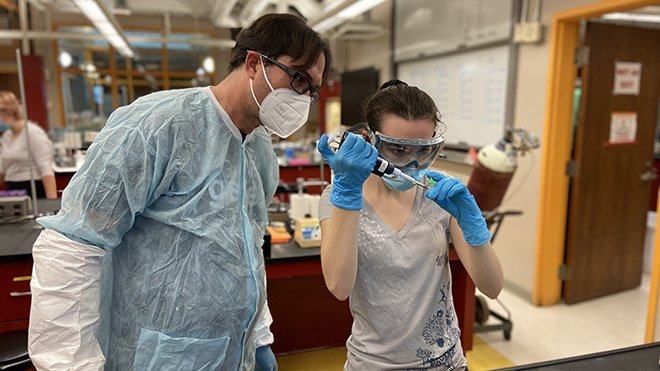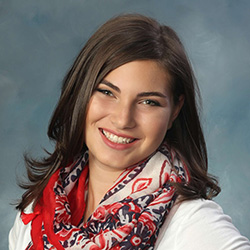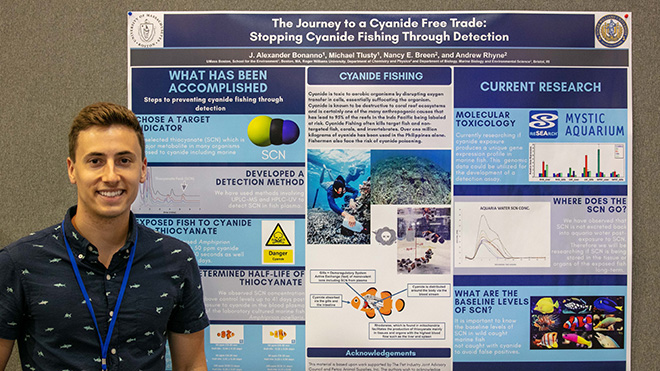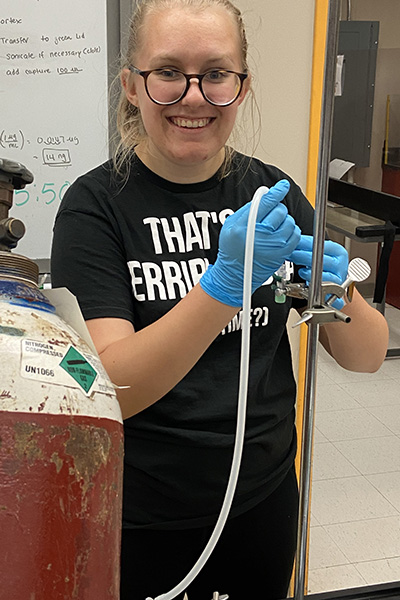RWU Marine Biology, Chemistry Collaboration Offers Interdisciplinary Research Experience for Students
“It was a unique opportunity that I couldn’t have gotten if I had gone anywhere else,” said Julia Grossman ’21.

BRISTOL, R.I. – When she was a freshman at Roger Williams University majoring in Marine Biology, Julia Grossman ’21 learned about a unique research opportunity with the Chemistry department that changed her academic path and eventually helped her land her current position as an associate scientist at Averica Discovery in Massachusetts.
“It was a unique opportunity that I couldn’t have gotten if I had gone anywhere else,” she said of her research at RWU. “It’s expanded my opportunities and what I can do [in my career] as a scientist.”

Grossman worked with an RWU research team, led by Andrew Rhyne, a professor of Marine Biology, and Nancy Breen, a professor of Chemistry, which has been working to create the first viable test to determine if marine fish were captured using cyanide, a harmful, illegal chemical compound. Cyanide fishing, a major problem in the Indo-Pacific region, is also responsible for the destruction of some coral reefs. Their research could hold a key to improving the marine aquarium trade.
Once she began working on the cyanide project as a freshman, Grossman said Rhyne and Breen encouraged her to explore Chemistry. “I’m glad that they did,” she said. In 2021 she graduated with bachelor’s degrees in both Marine Biology and Environmental Chemistry and said that the interdisciplinary experience expanded her skillset and opened up more career opportunities for her.
J. Alexander Bonanno ’17, who majored in Marine Biology at RWU and also worked on the cyanide research project, agreed. Being part of this interdisciplinary research, “I was able to dip my toes in so many different areas, which gave me flexibility to do so many different things when I graduated,” he said.
Bonanno, who graduated from UMass Boston in 2020 with a master’s degree in marine science and technology, now works as a territory manager for Takara Bio USA. Having the chance to also learn and apply chemistry and molecular biology is what helped him land his current position, he said.
Hands-on experience sets RWU students apart
“Having the ability to work on this project as an undergraduate was huge for getting hands-on experience, which led me to going to graduate school,” said Bonanno, who continued to work on this research at RWU as a graduate student at UMass Boston.

As part of the research, Bonanno and Grossman – and other students including Jordan Brown ’18, Hannah Nolte ’18, and Sara Hunt ’19 – have contributed to faculty-student collaborative research publications in prestigious scholarly journals, getting their first published research credentials during their undergraduate careers.
Rhyne and Breen’s research has spanned six years, providing numerous students, from freshmen to seniors, a real-world, interdisciplinary research experience that opens their eyes to the possibilities of research and professional opportunities at the intersection of biology and chemistry, Breen said. It prepares them for careers in many industries including biotech and pharmaceuticals.
As part of hands-on research with Rhyne and Breen, students intake, grow, and care for clownfish and collect and process samples for complex chemical procedures, everything except expose fish to cyanide, which is the only step strictly handled by faculty.
Many seniors on the project started as freshmen, Breen said. “That’s exceptional. They get to do a really deep dive on this and see how the science is done.”
Marine biology students may not understand why math or chemistry is needed in biology, and this research provides them with a concrete, real-life example. “It puts all that together for them,” Rhyne said. “It’s a rare opportunity for students to engage in something like this.”

Another great opportunity arising from this research is benefitting student researchers this year. Three current seniors working on the cyanide research – Julia Dwyer, who’s majoring in Chemistry and Marine Biology; Marion Olsen, who’s majoring in Chemistry and Biology; and Elizabeth Sanford, who’s majoring in Chemistry – have each been awarded $450 to present their research in the Analytical Chemistry Division at the National Meeting of the American Chemical Society Meeting in March in San Diego, Calif.
In addition to lab work, Bonanno said Rhyne and Breen involve their students in all aspects of research, from keeping inventory to helping with grant writing, budgeting, and writing publications. “Being able to be a part of all the steps really helped in moving my career along,” he said. “I owe a lot to Andy and Nancy.”
Interdisciplinary collaboration could benefit blue economy
The research, which could have far-reaching impacts on conservation and international commerce in the blue economy, requires this unique interdisciplinary collaboration to be successful, one of the benefits of having small departments in the same building, Rhyne said.
“When you work together, you can do things you can’t normally do,” he said. “It’s a really underserved area. It’s a complex problem that requires understanding of fish and chemistry. This work is not possible without chemistry.”
This can be the case for many biological and public health issues, Breen noted: chemists often lay the groundwork for biologists, including creating cutting-edge tools such as Covid-19 tests. “That’s chemistry, not biology,” Breen said.

In their latest study to be published by PeerJ, “The determination of thiocyanate in the blood plasma and holding water of Amphiprion clarkii after exposure to cyanide,” co-authored by Rhyne, Breen, Bonanno, Michael F. Tlusty, of the University of Massachusetts Boston, and Lawrence Andrade, of Dominion Diagnostics, the team proved that blood tests are possible to determine cyanide exposure but that testing muscle tissue may prove a better option. It’s another step in their process proving that a chemical blood test is the best, and only, option for developing the first-ever cyanide detection test in fish that have been collected for the marine aquarium trade or as fish for human consumption.
The professors and student researchers will continue their work this spring, with a new focus on collecting data from other fish species. “We’re much closer today than we were six years ago to having a viable solution to the problem,” Rhyne said.
A commercial test that reliably detects cyanide fishing holds significant benefits in particular for the aquarium hobbyist trade, a multimillion-dollar global industry. Solving the issue of destructive fishing reduces pressure on marine ecosystems and allows a sustainable fish-collection trade to resume or take hold for many local communities, Rhyne said. In places that have been able to police and manage cyanide fishing, coral reefs are growing back, and communities are benefiting both from the positive environmental bounce back and a better fishery economy.
As Breen said, “There is no blue economy when the coral reefs die.”